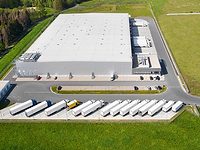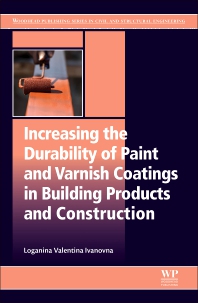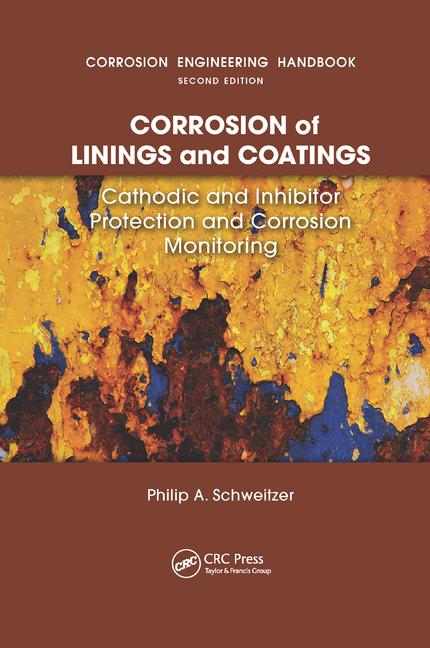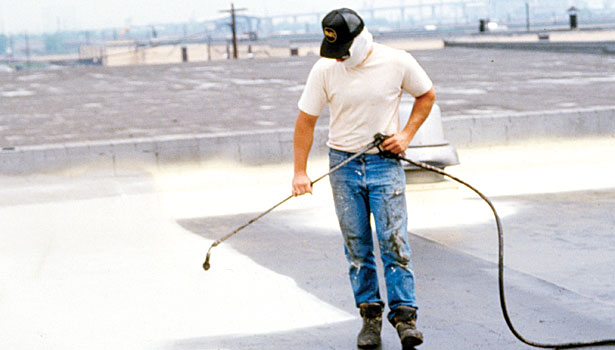Early Rain Resistance Marks Next Step in Evolution of Elastomeric Roof Coatings
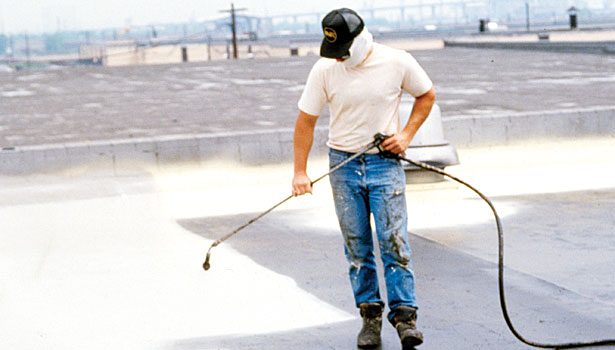



| Roof Coating Tips |
| Benefits of Elastomeric Roof Coatings |
| Applying Elastomeric Roof Coatings |
| Formulation and Application Tips |
As many commercial building owners and operators know, there are numerous benefits to applying elastomeric roof coatings (ERCs) to low-slope and flat roofs. For instance, ERCs can extend the service life of roofs and lower their overall lifecycle costs. Another benefit is reducing a roof’s heat load. The white roof coating reflects light, which helps to keep buildings cooler, thus reducing expensive air conditioning costs. With growing interest in energy efficiency and the urban heat island effect, many municipalities are encouraging ERC applications through various programs and incentives.
While the end-result benefits are widely known, there’s still one application obstacle many roof coating contractors have had to overcome in the past – the weather. Today, a new technology is helping to minimize this obstacle so contractors can coat roofs quickly and more easily. RHOPLEX™ EC-3000, a 100% acrylic polymer, was developed to address the need for improved hard rain resistance in ERCs. It helps set to the point of hard rain resistance in about 20 minutes.
ERC Performance Properties and Benefits
Many roof coating contractors are familiar with the sinking feeling that comes when rain and thunder clouds roll in during the middle of a coating application. If the coating isn’t set when the rain hits, the results can be ugly and the callbacks costly. Conventional water-based roof coatings take up to eight hours to dry to the point of hard rain resistance, therefore, rain that falls within eight hours of a crew leaving a job can wash the coating off the roof and create a huge mess to clean up. To help solve the needs of coating contractors in these situations, Dow investigated how to accelerate the fast set of ERCs, starting with – and building on – the company’s advances in acrylic chemistry.
Acrylics are well-known for their durability. When they are used in ERCs and fully cured, they extend the life of the roof by protecting the underlying substrate from degradation caused over time by exposure to rain, snow, wind and UV light. To achieve these benefits, the acrylic coating must be strong and durable, but it also has to have the ability to expand and contract with the substrate. Even within a single 24-hour period, a roof can undergo dramatic shifts in surface temperature, especially in temperate climates. Hot summers, cold winters and the variable bridge seasons of spring and autumn (when daytime heating from the sun alternates with significant nighttime cooling) all contribute to roof movement and mechanical stress. The ERC must be able to move with the roofing substrate – bridging and spanning small cracks that can develop as the temperature fluctuates.
While first-generation ERCs were elastic and flexible, they adhered to only a handful of roofing materials and required unique formulations for each type. Contractors had to use different coating materials for different substrates – creating an extra step and adding time to the application process. Today, 100% acrylic binders, like RHOPLEX EC-2885 and others, offer excellent adhesion to a wide range of substrates, including asphalt, concrete, metal, rubber, aged PVC, synthetic membrane, modified bitumen and even polyurethane foam.
Elasticity is another critical performance property of ERCs and relies on the use of a soft binder. In early version ERCs, soft binders also meant tacky binders. ERCs made with tacky binders had poor dirt pick-up resistance – meaning the coatings dulled quickly and required cleaning or re-coating to restore their white color and resulting reflectivity. With increasing awareness of cool roofs and increasing interest in more affordable cooling, dirt pick-up resistance has became an important performance property of ERCs and was incorporated into binders, such as RHOPLEX EC-1791, to keep roofs white and reflective.
Today, water-based ERCs using 100% acrylic binders offer many benefits to both the coating applicator and the building owner. Typically, these ERCs retain excellent elasticity at temperatures as low as -15 °F (-26 °C). They are expected to adhere to multiple types of substrates, and they offer better dirt pick-up resistance than their predecessors. They also are meant to facilitate formulations with <50 g/L VOCs. When fully cured, they act as long-term, durable barriers against rain, snow, wind and UV light. With regular maintenance, including re-coating every 10 to 15 years, a coated roof could potentially last for the lifetime of the building underneath it. While this is all good news for the building owner, it still doesn’t solve weather-related application challenges for the roof coating contractor.
A Longer Application Season
High humidity and low temperatures increase coating dry time, and rain can wash away or damage a coating that hasn’t cured.
Applying an ERC that sets quickly is crucial in geographies where humidity and rain accompany either a warm or cool climate throughout much of the year. However, conventional water-based acrylic ERCs require four to eight hours drying time to be considered rain-resistant, and even most quick-set acrylic technologies need at least an hour to set and, even then, resistance is limited to light rain and dew formation. RHOPLEX EC-3000 goes several steps further with next-generation, quick-set polymer technology.
The quick-set technology in EC-3000 accelerates the first phase of film formation by creating a gel structure that imparts immediate tensile strength in as little as 20 minutes after application. The coating isn’t completely cured at this stage, but it’s tough enough to remain intact even during a sudden heavy rain. In other words, it won’t run off or bubble up as with other ERCs. When it stops raining and the sun comes out, the water continues to evaporate and the coating continues to dry as normal.
While reducing rain delays and water washouts were the major impetus behind developing accelerated quick-set technology, the new chemistry in RHOPLEX EC-3000 can also help contractors extend their application season. In some parts of the United States, contractors may stop applying roof coatings in the middle of October because they take too long to dry in cool weather. But with the faster setting technology in EC-3000, it’s possible to extend the application season into November, as well as to start earlier the following spring. In certain circumstances, EC-3000 technology is known to extend the shoulder seasons by two to four weeks at either end. So not only does it help provide the benefit of heavy rain resistance, it also offers roof coating applicators another way to maximize their seasons.
Formulation and Application Tips
At the formulation stage, formulators who use RHOPLEX EC-1791 can often use EC-3000 as a drop-in replacement for the EC-1791, without having to change their current formulations. There also is a starting-point formulation for EC-3000 that can be followed.
To achieve the best application results, ERCs based on RHOPLEX EC-3000 technology should be applied by brush, roller or spray-application on polyurethane foam, metal, concrete, or aged asphalt roofs. These coatings should be applied at a minimum of 18-20 dry mil thickness (about 2.5 gallons per square) in two passes – allowing usually four or more hours under normal conditions between passes before applying the second coat. Water-based coatings based on EC-3000 should be applied at temperatures of 50 °F (10 °C) and rising, and not when temperatures fall below 40 °F (5 °C). ERCs based on EC-3000 should also not be applied at very high (>90%) relative humidity or when rain has already begun, when impending rain is expected to last more than one hour, or on roofs collecting ponded water. As you might expect, applicators must know the weather conditions on the day of application and understand how to modify the above application recommendations to facilitate a properly applied ERC job.
From improved adhesion to higher dirt pick-up resistance, advances in acrylic binder chemistry have elevated the performance of ERCs, with a ripple effect on consumer demand. With continued improvements like early rain resistance in RHOPLEX EC-3000, formulators and roof coating contractors will have the tools they need to keep up with demand.
*This information is offered in good faith for your consideration, but without guarantee or warranty (express or implied), as analytical conditions and methods of use of the information and materials described herein may vary and are out of Dow’s control. Although this information is based on data Dow believes to be reliable and accurate, we do not intend for you to use, and you therefore should not construe, the contents of this document as business, technical or any other form of advice. We recommend you determine the suitability of the information and materials described herein before adopting or using them on a commercial scale. Dow assumes no liability in connection with the use of this information.
®™Trademark of The Dow Chemical Company (“Dow”) or an affiliated company of Dow.
Looking for a reprint of this article?
From high-res PDFs to custom plaques, order your copy today!




